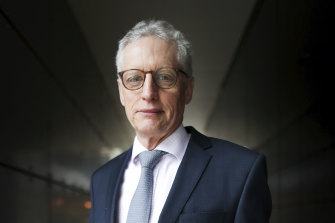Australia is bigger, more diverse, census shows
Australia is bigger, more diverse and less religious, the latest census data shows.
The first tranche of data from the 2021 census, released by the Australian Bureau of Statistics at 10am today, reveals almost half of Australians have a parent born overseas and more than a quarter of Australian residents were born outside the country.
David Gruen, chief statistician for the Australian Bureau of Statistics, spoke about the census results.Credit:Alex Ellinghausen
The number of Australians born in India increased dramatically since 2016, and it has now gone past China and New Zealand in the country-of-birth statistic to sit behind only Australia and England. The second-largest increase in country of birth was Nepal, with an additional 70,000 people.
Australian Bureau of Statistics’ chief statistician David Gruen spoke to ABC Radio National and said this year’s data showed Australia is “obviously bigger, more diverse, with a significantly larger number of people who identify as Aboriginal and Torres Strait Islander and more migrants”.
The data collecting information on more than 250 ancestries and 350 languages shows the number of people who used a language other than English at home increased by to more than 5.5 million people since 2016. Of those, 850,000 reported that they did not speak English well or at all.
Mandarin continues to be the most common language, other than English, with nearly 700,000 people speaking it at home. This is followed by Arabic. Punjabi had the largest increase.
The data also revealed the Baby Boomers’ time at the centre of Australian economic and policy debate is ending, as they are now matched in number by Millennials.
Boomers and Millennials now each account for 21.5 per cent of the nation’s 25.5 million residents. There are about 5.4 million in each generation. Just 5662 more Boomers were counted on August 10 last year.
Australia’s overall population increased by 2.2 million, or 8.6 per cent, to 25.5 million between the 2016 and 2021 censuses. The number of Indigenous Australians increased by 25.2 per cent over the same period to more than 812,000.
Australia has become less religious over the past decade, with the proportion of self-identified Christians dropping below 50 per cent for the first time and a soaring number of people describing themselves as “non-religious”.
Just 44 per cent of Australians now identify as Christian, down from 52 per cent five years earlier and 61 per cent in 2011.
When the first census was conducted in 1911, 96 per cent of Australians listed a form of Christianity as their religion.
The proportion of Australians identifying as Catholic declined from 23 to 20 per cent over the past five years, while self-identified Anglicans dropped from 13 to 10 per cent.
Thirty-nine per cent of Australians now identify as non-religious, up from 30 per cent in 2016 and almost double the 22 per cent of Australians who ticked the “no religion” box a decade ago.
More to come.
Cut through the noise of federal politics with news, views and expert analysis from Jacqueline Maley. Subscribers can sign up to our weekly Inside Politics newsletter here.
Most Viewed in National
From our partners
Source: Read Full Article
